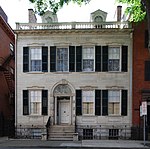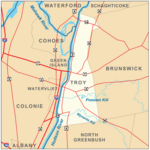Troy Savings Bank Music Hall
Bank buildings on the National Register of Historic Places in New York (state)Buildings and structures in Troy, New YorkCommercial buildings completed in 1870Event venues on the National Register of Historic Places in New York (state)Historic district contributing properties in New York (state) ... and 3 more
Music venues in New York (state)National Historic Landmarks in New York (state)National Register of Historic Places in Troy, New York

Troy Savings Bank Music Hall, is a performance space in Troy, Rensselaer County, New York, United States. The music hall, renowned for its acoustics and an Odell concert organ, is operated by a not-for-profit organization. It was designated a National Historic Landmark in 1989 for its architecture as one of the finest surviving 19th-century auditoriums.
Excerpt from the Wikipedia article Troy Savings Bank Music Hall (License: CC BY-SA 3.0, Authors, Images).Troy Savings Bank Music Hall
2nd Street, City of Troy
Geographical coordinates (GPS) Address Phone number External links Nearby Places Show on map
Geographical coordinates (GPS)
| Latitude | Longitude |
|---|---|
| N 42.730277777778 ° | E -73.691388888889 ° |
Address
Troy Savings Bank Music Hall
2nd Street 30
12180 City of Troy
New York, United States
Open on Google Maps









